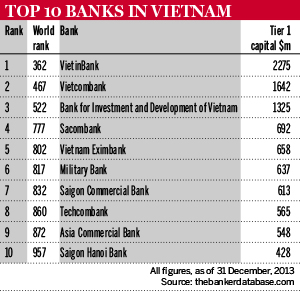In the beginning there was just one bank in communist Vietnam, and that bank was the central bank, the State Bank of Vietnam (SBV). Now there are about 40 state-owned, partly state-owned and private banks. The country’s banking sector is undergoing a major restructure with improved governance standards. The issue of high non-performing loans (NPLs) is being tackled and there has been an influx of foreign investment.
Editor's choice
The first big initiative in Vietnam’s banking sector came in 1988 when the SBV hived off four former divisions, turning them into AgriBank (for agriculture), VietinBank (for industry), VietcomBank (for trade) and Bank for Investment and Development of Vietnam, or BIDV (for infrastructure), similar to China's model of state banking.
Poor timing
In the early 1990s, the SBV granted licences to primarily private joint stock banks and then right before Vietnam entered the World Trade Organisation (WTO) in 2007, a score of new national-level banks entered the picture when Vietnamese businessmen bought up small provincial banks in anticipation of the country’s economic take-off.
Instead of heralding its economic miracle, Vietnam’s WTO membership coincided with the 2008 global financial crisis. At home, after years of credit-driven growth (lending averaged increases of 33% between 2004 to 2011), Vietnam experienced a stock market crash in 2010, a real estate bust in 2011 and subsequently an NPL crisis in 2012 that has yet to be fully resolved. By the end of 2012, the sector’s cumulative NPLs had reached 12% of all loans, according to World Bank estimates.
Vietnamese banks reported cumulative NPLs of about 5% in 2014, but the SBV estimates the ratio to be closer to 9%, while some observers say a more realistic figure is 15%. Nobody knows for sure, partly because of the different ways of classifying NPLs. In its latest analysis of Vietnam’s financial sector, the World Bank expressed concerns over “the quality of financial data amid the country’s inadequate loan classification and provisions rules, unreliable valuation of collateral and questionable classification of some assets as liquid”.
NPL crisis
To tackle the NPL crisis, the SBV has taken several steps. In 2011, it announced a goal to consolidate the country's banks from the current list of 40 to between 15 and 17 by 2016. Observers say a target of 20 banks by 2020 might be more realistic. In July 2013, the SBV established the Vietnam Assets Management Company (VAMC), with $24m in capital to buy NPLs from the banks in exchange for zero-interest government bonds. In its first seven months, the mechanism purchased some $2.5m-worth of bad debt, but buying then slowed.
"The VAMC would like to sell the bad debt in the debt market, otherwise you can't solve the bad debt," says Vo Tri Thanh, vice-president of Vietnam's Central Institute for Economic Management. "So the first problem is how to develop a debt market." Much of the bad loan collateral is in property, which neither foreigners nor Vietnamese citizens can own outright in the communist country, where land still belongs to the state. To resolve this issue, laws would need to be changed, which takes time and political will.
One easy fix for Vietnam’s bad debts problem would be to let foreign investors play a bigger role, which the government is considering. In February, the government raised the ceiling of single foreign holdings in a bank to 20%, from 15%, and added a provision that the prime minister could lift the ownership cap for needy banks.
There is talk of authorities allowing up to 51% foreign ownership in some smaller banks. “If there was an opportunity for a foreign bank to own more than 51% of a local bank, I think foreign investors would be very interested,” says Steve Punch, Vietnam director of accountancy firm KPMG.
As well as potentially helping to recapitalise the sector, foreign investment in Vietnamese banks could also help to dilute some of the cross-ownership between banks and borrowers that contributed to the current problems. While many of the private banks were said to be using deposits to finance their own projects, principally in real estate, government and provincial authorities were reported to be using the state banks to finance state-owned enterprises (SOEs), many of which had also ventured into the property boom.
State bank restructuring
Vietnam’s big four state-run banks – AgriBank, VietinBank, BIDV and VietcomBank – account for about 50% of the sector’s loans and 38% of the total charter capital, according to a KPMG survey. These banks also account for the lion’s share of the sector’s NPLs, say observers. The government has made a priority of restructuring the banking sector as a necessary step towards stabilising the economy, which is expected to grow by 5.5% to 5.6% this year, modest by Vietnam standards.
Allowing foreign banks a role has been part of the restructuring process. In 2011, Mizuho Corporate Bank bought a 15% stake in VietcomBank, and in 2012 Bank of Tokyo-Mitsubishi UFJ (BTMU) took a 19.73% stake in VietinBank, which also sold a 10% stake to the International Finance Corporation (IFC) in 2011. BIDV is in the market for financial investors and a strategic partner, and hopes to finalise the agreement by next year.
“[Foreign investors] will buy up to 30% of the chartered capital of BIDV, which means that by the end of 2015 the percentage held by the state would be about 65%,” says Tran Phuong, BIDV’s senior executive vice-president. In December 2011, BIDV had an initial public offering (IPO), selling 4.24% of the bank to the public. “We have a plan – of course with the permission of the prime minister – to reduce the state stake down to 51% in the next five years,” says Mr Tran.
BIDV’s ideal partner would not only help with recapitalisation, something most of Vietnam's banks need after their hefty provisioning for NPLs, but would also help improve governance, retail banking activities, risk management and technical assistance in compliance with Basel II (to be fully enforced within five years) and upgrading its IT system, says Mr Tran.
VietinBank, which is now 64.5% state owned, has already benefited in such areas from its strategic alliance with BTMU. VietinBank general-director Le Duc Tho says the BTMU investment has not only helped to recapitalise the bank but also “improved our corporate governance and enhanced our risk management capabilities. For example, we’ve developed procedures in credit risk activities and in liquidity risk management.” Mr Le says that VietinBank’s NPLs were only 2.05% by July 21 this year.
Retail expansion
Another area where BTMU has helped has been in guiding VietinBank’s expansion into retail banking, such as payment services, consumer loans for house and car purchases, and loans to small and medium-sized enterprises (SMEs.) “We aim to have retail customers account for 30% to 35% of our revenues,” says Mr Le, an increase on the current figure of 20%.
BIDV, which edges out VietinBank as the second largest bank in Vietnam in terms of deposits and credits according to mid-year results, is likewise expanding into retail and trade finance, stepping into the traditional preserve of VietcomBank. The bank’s current credit make-up is 16% retail, 22% SOEs and 62% private companies, claims Mr Tran. It has no intention to stop lending to SOEs, despite the NPL crisis. “We are prioritising the more profitable SOEs such as PetroVietnam,” he says. “The criticism of the SOEs isn’t always fair because they are the pillars of the economy in many sectors.”
One state bank that has no plans to seek a foreign partner is the 100% state-owned AgriBank, Vietnam’s largest bank in assets and branch network. “In our restructuring strategy up to 2017, there is no change in our equity make-up; it remains government policy to keep us 100% state owned,” says Nguyen Hai Long, AgriBank’s director of financial institutions.
The bank has not divulged its NPL ratio for this year, although it has set a target of a figure below 3% by 2015. Established to help farmers and small households, during the economic boom AgriBank branched out into non-agricultural ventures in Ho Chi Minh City and Hanoi, which went some way to causing an increase in NPLs. AgriBank is now returning to its original mandate.
“The restructuring plan, in financial terms, is that AgriBank should focus on farmers and SMEs in agriculture,” says Mr Nguyen. And it is well positioned to do so. The bank has 780 branches and 2300 sub-branches nationwide, 40,000 staff, 9 million depositors and 30,000 SME customers. The NPL ratio to farmers is less than 3%, says Mr Nguyen.
AgriBank has also been branching out into mobile phone services. “There are about 140 million mobile phones in Vietnam. This makes us optimistic,” says Nguyen Viet Hai, deputy director of product research and development at AgriBank.
Go medium
While the big four state-run banks are expected to remain the main players in the market, medium-sized private banks, of which there are eight, are deemed more dynamic institutions with the greatest growth potential. For example, Techcombank, 19.41% owned by HSBC, has been taking the lead in retail banking. Chief financial officer Vikesh Mirani says: “Techcombank will maintain its lead by having a strong technology foundation, a wide network of branches and by developing and implementing more alternative sale channels in the future.”
As of June 30, Techcombank had 315 branches nationwide and reported a credit rate growth of 5.3%, compared with the industry average of 3.52%, and a 45% increase in profits before tax.
Foreign banks already have a considerable presence in Vietnam, where HSBC, ANZ, Standard Chartered, Shinhan Bank and Hong Leong Bank have been incorporated as 100% foreign-owned entities allowed to set up a branch network and pursue most bank activities. ANZ, for instance, has been expanding its retail services in areas such as mortgages.
“Most of our clients are actually the emerging affluent – people who have salaries, who want a good credit card that works, a good reward programme, a professional reply on a mortgage process and some choices on investment solutions,” says Tareq Muhmood, ANZ’s chief executive in Vietnam.
On the corporate side, Mr Muhmood estimates that half of ANZ's lending is to foreign investors and half to local corporations, including some SOEs. “The SOEs are still a big part of this economy. You ignore them at your peril,” he says.
Future prospects
Vietnam’s SOEs, which account for a good deal of the banks' NPLs, have been slated for reform, with an estimated 400 firms up for equitisation soon and IPOs planned for behemoths such as Vietnam Airlines and telecoms firm Mobifone by next year. But with a party congress not due until early 2016, most observers do not expect drastic changes in Vietnam’s state-controlled economy any time soon. “It is the mindset. The government still thinks that the core of development should be about the SOEs and the state. Otherwise it will lose control,” says Nguyen Duc Thanh, director of the Vietnam Centre for Economic and Policy Research.
That said, there have been lessons learned from the NPL crisis. “What may be new is people are recognising the fact that certain lending practices do not necessarily make money for lenders,” says Adel Meer, IFC’s east Asia manager for financial institutions. Another positive development is the new focus on retail banking. “I think it’s great,” says KPMG’s Mr Punch. “Vietnam is underbanked with an estimated 15% to 20% of the people actually holding bank accounts.”
Assuming the economy continues to recover, and the real estate market improves, most observers think that Vietnam's NPL problem will be solved. “There will be no collapse,” says Mr Vo. “In Vietnam we have SOEs, state banks and many kinds of administrative instruments not noted in the textbooks. Of course the cost of using these instruments is quite high, but to avoid a collapse they can be used.”













